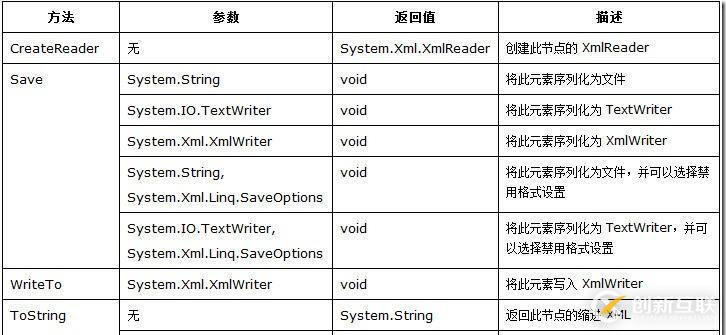如何使用LINQtoXML創(chuàng)建xml-創(chuàng)新互聯(lián)
這篇文章給大家分享的是有關(guān)如何使用LINQ to XML創(chuàng)建xml的內(nèi)容。小編覺得挺實(shí)用的,因此分享給大家做個(gè)參考,一起跟隨小編過來看看吧。

1、LINQ to XML類

以下的代碼演示了如何使用LINQ to XML來快速創(chuàng)建一個(gè)xml:
隱藏行號(hào) 復(fù)制代碼 ? 創(chuàng)建 XML
public static void CreateDocument()
{
string path = @"d:\website";
XDocument xdoc = new XDocument(new XDeclaration("1.0", "utf-8", "yes"),
new XElement("Root", "root"));
xdoc.Save(path);
}運(yùn)行該示例將會(huì)得到一個(gè)xml文件,其內(nèi)容為:
<?xml version="1.0" encoding="utf-8" standalone="yes"?> <Root>root</Root>
2、XElement類
XElement 類是 LINQ to XML 中的基礎(chǔ)類之一。 它表示一個(gè) XML 元素。 可以使用該類創(chuàng)建元素;更改元素內(nèi)容;添加、更改或刪除子元素;向元素中添加屬性;或以文本格式序列化元素內(nèi)容。 還可以與 System.Xml 中的其他類(例如 XmlReader、XmlWriter 和 XslCompiledTransform)進(jìn)行互操作。
使用LINQ to XML創(chuàng)建xml文檔有很多種方式,具體使用哪種方法要根據(jù)實(shí)際需要。而創(chuàng)建xml文檔最簡單、最常見的方式是使用XElement類。以下的代碼演示了如何使用XElement類創(chuàng)建一個(gè)xml文檔:
顯示行號(hào) 復(fù)制代碼 ? 這是一段程序代碼。
public static void CreateCategories()
{
string path = @"d:\website";
XElement root = new XElement("Categories",
new XElement("Category",
new XElement("CategoryID", Guid.NewGuid()),
new XElement("CategoryName", "Beverages")
),
new XElement("Category",
new XElement("CategoryID", Guid.NewGuid()),
new XElement("CategoryName", "Condiments")
),
new XElement("Category",
new XElement("CategoryID", Guid.NewGuid()),
new XElement("CategoryName", "Confections")
)
);
root.Save(path);
}運(yùn)行該示例將會(huì)得到一個(gè)xml文件,其內(nèi)容為:
<?xml version="1.0" encoding="utf-8"?> <Categories> <Category> <CategoryID>57485174-46fc-4e8c-8d98-d25b53d504a1</CategoryID> <CategoryName>Beverages</CategoryName> </Category> <Category> <CategoryID>1474dde1-8014-48f7-b093-b47ca5d5b770</CategoryID> <CategoryName>Condiments</CategoryName> </Category> <Category> <CategoryID>364224e0-e002-4939-90fc-0fd93e0cf35b</CategoryID> <CategoryName>Confections</CategoryName> </Category> </Categories>
XElement類包含了許多方法,這些方法使得處理xml變得輕而易舉。有關(guān)這些方法請(qǐng)參照MSDN。
其中,Save、CreateReader、ToString和WriteTo方法是比較常用的三個(gè)方法:

3、XAttribute類
XAttribute類用來處理元素的屬性,屬性是與元素相關(guān)聯(lián)的“名稱-值”對(duì),每個(gè)元素中不能有名稱重復(fù)的屬性。使用XAttribute類與使用XElement類的操作十分相似,下面的示例演示了如何在創(chuàng)建xml樹時(shí)為其添加一個(gè)屬性:
顯示行號(hào) 復(fù)制代碼 ? 這是一段程序代碼。
public static XElement CreateCategoriesByXAttribute()
{
XElement root = new XElement("Categories",
new XElement("Category",
new XAttribute("CategoryID", Guid.NewGuid()),
new XElement("CategoryName", "Beverages")
),
new XElement("Category",
new XAttribute("CategoryID", Guid.NewGuid()),
new XElement("CategoryName", "Condiments")
),
new XElement("Category",
new XAttribute("CategoryID", Guid.NewGuid()),
new XElement("CategoryName", "Confections")
)
);
root.Save(path);
return root;
}運(yùn)行該示例將會(huì)得到一個(gè)xml文件,其內(nèi)容為:
<?xml version="1.0" encoding="utf-8"?> <Categories> <Category CategoryID="a6d5ef04-3f83-4e00-aeaf-52444add7570"> <CategoryName>Beverages</CategoryName> </Category> <Category CategoryID="67a168d5-6b22-4d82-9bd4-67bec88c2ccb"> <CategoryName>Condiments</CategoryName> </Category> <Category CategoryID="17398f4e-5ef1-48da-8a72-1c54371b8e76"> <CategoryName>Confections</CategoryName> </Category> </Categories>
XAttribute類的方法比較少,常用的三個(gè)是:

以下的示例使用Remove來刪除第一個(gè)元素的CategoryID屬性:
顯示行號(hào) 復(fù)制代碼 ? 這是一段程序代碼。
public static void RemoveAttribute()
{
XElement xdoc = CreateCategoriesByXAttribute();
XAttribute xattr = xdoc.Element("Category").Attribute("CategoryID");
xattr.Remove();
xdoc.Save(path);
}運(yùn)行該示例將會(huì)得到一個(gè)xml文件,其內(nèi)容為:
<?xml version="1.0" encoding="utf-8"?> <Categories> <Category> <CategoryName>Beverages</CategoryName> </Category> <Category CategoryID="5c311c1e-ede5-41e5-93f7-5d8b1d7a0346"> <CategoryName>Condiments</CategoryName> </Category> <Category CategoryID="bfde8db5-df84-4415-b297-cd04d8db9712"> <CategoryName>Confections</CategoryName> </Category> </Categories>
作為嘗試,試一試以下刪除屬性的方法:
public static void RemoveAttributeByDoc()
{
XElement xdoc = CreateCategoriesByXAttribute();
XAttribute xattr = xdoc.Attribute("CategoryID");
xattr.Remove();
xdoc.Save(path);
}運(yùn)行該示例將會(huì)拋出一個(gè)空引用異常,因?yàn)樵谻ategories沒有一個(gè)叫做CategoryID的屬性。
4、XDocument類
XDocument類提供了處理xml文檔的方法,包括聲明、注釋和處理指令。一個(gè)XDocument對(duì)象可以包含以下內(nèi)容:

下面的示例創(chuàng)建了一個(gè)簡單的xml文檔,它包含幾個(gè)元素和一個(gè)屬性,以及一個(gè)處理指令和一些注釋:
public static void CreateXDocument()
{
XDocument xdoc = new XDocument(
new XProcessingInstruction("xml-stylesheet", "title='EmpInfo'"),
new XComment("some comments"),
new XElement("Root",
new XElement("Employees",
new XElement("Employee",
new XAttribute("id", "1"),
new XElement("Name", "Scott Klein"),
new XElement("Title", "Geek"),
new XElement("HireDate", "02/05/2007"),
new XElement("Gender", "M")
)
)
),
new XComment("more comments")
);
xdoc.Save(path);
}運(yùn)行該示例將會(huì)得到一個(gè)xml文件,其內(nèi)容為:
<?xml version="1.0" encoding="utf-8"?> <?xml-stylesheet title='EmpInfo'?> <!--some comments--> <Root> <Employees> <Employee id="1"> <Name>Scott Klein</Name> <Title>Geek</Title> <HireDate>02/05/2007</HireDate> <Gender>M</Gender> </Employee> </Employees> </Root> <!--more comments-->
XDocument類包含多個(gè)與XElement類相同的方法,具體內(nèi)容可以參閱MSDN。需要注意的是,處理節(jié)點(diǎn)和元素的大部分功能都可以通過XElement獲得,只有當(dāng)絕對(duì)需要文檔層次的處理能力,以及需要訪問注釋、處理指令和聲明時(shí),才有使用XDocument類的必要。
創(chuàng)建了xml文檔后,可以使用NodesAfterSelf方法返回指定的XElement元素之后的所有同級(jí)元素。需要注意的是,此方法只包括返回集合中的同級(jí)元素,而不包括子代。此方法使用延遲執(zhí)行。以下代碼演示了這一過程:
顯示行號(hào) 復(fù)制代碼 ? 這是一段程序代碼。
public static void NodesAfterSelf()
{
XElement root = new XElement("Categories",
new XElement("Category",
new XElement("CategoryID", Guid.NewGuid()),
new XElement("CategoryName", "食品"),
new XElement("Description", "可以吃的東西")
)
);
foreach (var item in root.Element("Category").Element("CategoryID").NodesAfterSelf())
{
Console.WriteLine((item as XElement).Value);
}
}二、LINQ to XML編程概念
本節(jié)將介紹LINQ to XML編程的相關(guān)概念,例如如何加載xml、創(chuàng)建全新xml、操縱xml的信息以及遍歷xml文檔。
1、加載已有的xml
使用LINQ to XML加載xml可以從多種數(shù)據(jù)源獲得,例如字符串、XmlReader、TextReader或文件。
下面的示例演示了如何從文件中加載xml:
public static void LoadFromFile()
{
XElement root = XElement.Load(path);
Console.WriteLi也可以使用Parse方法從一個(gè)字符串加載xml:
public static void LoadFromString()
{
XElement root = XElement.Parse(@"
<Categories>
<Category>
<CategoryID>1</CategoryID>
<CategoryName>Beverages</CategoryName>
<Description>Soft drinks, coffees, teas, beers, and ales</Description>
</Category>
</Categories>
");
Console.WriteLine(root.ToString());
}2、保存xml
在前面的示例中曾多次調(diào)用XElement對(duì)象的Save方法來保存xml文檔,在這里就不冗述了。
3、創(chuàng)建xml
在前面的示例中曾多次調(diào)用XElement對(duì)象的構(gòu)造函數(shù)來創(chuàng)建xml文檔,在這里就不冗述了。需要說明的是,在使用LINQ to XML創(chuàng)建xml文檔時(shí),會(huì)有代碼縮進(jìn),這使代碼的可讀性大大加強(qiáng)。
4、遍歷xml
使用LINQ to XML在xml樹中遍歷xml是相當(dāng)簡單的。只需要使用XElement和XAttribute類中所提供的方法。Elements和Element方法提供了定位到某個(gè)或某些元素的方式。下面的示例演示了如何遍歷xml樹,并獲取指定元素的方式:
public static void Enum()
{
XElement root = new XElement("Categories");
using (NorthwindDataContext db = new NorthwindDataContext())
{
root.Add(
db.Categories
.Select
(
c => new XElement
(
"Category"
, new XElement("CategoryName", c.CategoryName)
)
)
);
}
foreach (var item in root.Elements("Category"))
{
Console.WriteLine(item.Element("CategoryName").Value);
}
}上述代碼運(yùn)行的結(jié)果為:

是不是很簡單呢?Nodes()、Elements()、Element(name)和Elements(name)方法為xml樹的導(dǎo)航提供了基本功能。
5、操縱xml
LINQ to XML一個(gè)重要的特性是能夠方便地修改xml樹,如添加、刪除、更新和復(fù)制xml文檔的內(nèi)容。
I.插入
使用XNode類的插入方法可以方便地向xml樹添加內(nèi)容:

在下面的示例中,使用AddAfterSelf方法向現(xiàn)有xml中添加一個(gè)新節(jié)點(diǎn):
public static void AddAfterSelf()
{
XElement root = XElement.Parse(@"
<Categories>
<Category>
<CategoryID>1</CategoryID>
<CategoryName>Beverages</CategoryName>
<Description>Soft drinks, coffees, teas, beers, and ales</Description>
</Category>
</Categories>
");
XElement xele = root.Element("Category").Element("CategoryName");
xele.AddAfterSelf(new XElement("AddDate", DateTime.Now));
root.Save(path);
}運(yùn)行該示例將會(huì)得到一個(gè)xml文件,其內(nèi)容為:
<?xml version="1.0" encoding="utf-8"?> <Categories> <Category> <CategoryID>1</CategoryID> <CategoryName>Beverages</CategoryName> <AddDate>2010-01-31T03:08:51.813736+08:00</AddDate> <Description>Soft drinks, coffees, teas, beers, and ales</Description> </Category> </Categories>
當(dāng)需要添加一個(gè)元素到指定節(jié)點(diǎn)之前時(shí),可以使用AddBeforeSelf方法。
II.更新
在LINQ to XML中更新xml內(nèi)容可以使用以下幾種方法:

在下面的示例中使用了ReplaceWith與SetElementValue方法對(duì)xml進(jìn)行了更新操作:
public static void Update()
{
XElement root = XElement.Parse(@"
<Categories>
<Category>
<CategoryID>1</CategoryID>
<CategoryName>Beverages</CategoryName>
<Description>Soft drinks, coffees, teas, beers, and ales</Description>
</Category>
</Categories>
");
root.Element("Category").Element("CategoryID").ReplaceWith(new XElement("ID", "2"));
root.Element("Category").SetElementValue("CategoryName", "test data");
root.Save(path);
}運(yùn)行該示例將會(huì)得到一個(gè)xml文件,其內(nèi)容為:
<?xml version="1.0" encoding="utf-8"?> <Categories> <Category> <ID>2</ID> <CategoryName>test data</CategoryName> <Description>Soft drinks, coffees, teas, beers, and ales</Description> </Category> </Categories>
III.刪除
可以使用Remove(XElement)與RemoveAll方法來刪除xml。
在下面的示例中,使用了RemoveAll方法:
}
public static void Remove()
{
string path = @"d:\";
XElement root = XElement.Parse(@"
<Categories>
<Category>
<CategoryID>1</CategoryID>
<CategoryName>Beverages</CategoryName>
<Description>Soft drinks, coffees, teas, beers, and ales</Description>
</Category>
</Categories>
");
root.RemoveAll();
root.Save(path);
}運(yùn)行該示例將會(huì)得到一個(gè)xml文件,其內(nèi)容為:
<?xml version="1.0" encoding="utf-8"?> <Categories />
在下面的示例中,使用了Remove方法刪除了xml的Description元素:
public static void Remove()
{
XElement root = XElement.Parse(@"
<Categories>
<Category>
<CategoryID>1</CategoryID>
<CategoryName>Beverages</CategoryName>
<Description>Soft drinks, coffees, teas, beers, and ales</Description>
</Category>
</Categories>
");
root.Element("Category").Element("Description").Remove();
root.Save(path);
}運(yùn)行該示例將會(huì)得到一個(gè)xml文件,其內(nèi)容為:
<?xml version="1.0" encoding="utf-8"?> <Categories> <Category> <CategoryID>1</CategoryID> <CategoryName>Beverages</CategoryName> </Category> </Categories>
6、處理屬性
I.添加
LINQ to XML添加屬性與添加元素師類似的,可以使用構(gòu)造函數(shù)或者Add方法來添加屬性:
public static void AddAttribute()
{
XElement root = new XElement("Categories",
new XElement("Category",
new XAttribute("CategoryID", "1"),
new XElement("CategoryName", "Beverages"),
new XElement("Description", "Soft drinks, coffees, teas, beers, and ales")
)
);
root.Element("Category").Add(new XAttribute("AddDate", DateTime.Now.ToShortDateString()));
root.Save(path);
}運(yùn)行該示例將會(huì)得到一個(gè)xml文件,其內(nèi)容為:
<?xml version="1.0" encoding="utf-8"?> <Categories> <Category CategoryID="1" AddDate="2010-01-31"> <CategoryName>Beverages</CategoryName> <Description>Soft drinks, coffees, teas, beers, and ales</Description> </Category> </Categories>
II.檢索
檢索屬性可以使用Attribute(name)方法:
顯示行號(hào) 復(fù)制代碼 ? 這是一段程序代碼。
public static void SelectAttribute()
{
XElement root = new XElement("Categories",
new XElement("Category",
new XAttribute("CategoryID", "1"),
new XElement("CategoryName", "Beverages"),
new XElement("Description", "Soft drinks, coffees, teas, beers, and ales")
)
);
XAttribute xattr = root.Element("Category").Attribute("CategoryID");
Console.WriteLine(xattr.Name);
Console.WriteLine(xattr.Value);
}上述代碼的運(yùn)行結(jié)果為:
CategoryID 1
感謝各位的閱讀!關(guān)于“如何使用LINQ to XML創(chuàng)建xml”這篇文章就分享到這里了,希望以上內(nèi)容可以對(duì)大家有一定的幫助,讓大家可以學(xué)到更多知識(shí),如果覺得文章不錯(cuò),可以把它分享出去讓更多的人看到吧!
另外有需要云服務(wù)器可以了解下創(chuàng)新互聯(lián)scvps.cn,海內(nèi)外云服務(wù)器15元起步,三天無理由+7*72小時(shí)售后在線,公司持有idc許可證,提供“云服務(wù)器、裸金屬服務(wù)器、高防服務(wù)器、香港服務(wù)器、美國服務(wù)器、虛擬主機(jī)、免備案服務(wù)器”等云主機(jī)租用服務(wù)以及企業(yè)上云的綜合解決方案,具有“安全穩(wěn)定、簡單易用、服務(wù)可用性高、性價(jià)比高”等特點(diǎn)與優(yōu)勢(shì),專為企業(yè)上云打造定制,能夠滿足用戶豐富、多元化的應(yīng)用場景需求。
新聞標(biāo)題:如何使用LINQtoXML創(chuàng)建xml-創(chuàng)新互聯(lián)
分享URL:http://www.chinadenli.net/article44/deedee.html
成都網(wǎng)站建設(shè)公司_創(chuàng)新互聯(lián),為您提供電子商務(wù)、App開發(fā)、做網(wǎng)站、移動(dòng)網(wǎng)站建設(shè)、網(wǎng)站營銷、網(wǎng)站設(shè)計(jì)
聲明:本網(wǎng)站發(fā)布的內(nèi)容(圖片、視頻和文字)以用戶投稿、用戶轉(zhuǎn)載內(nèi)容為主,如果涉及侵權(quán)請(qǐng)盡快告知,我們將會(huì)在第一時(shí)間刪除。文章觀點(diǎn)不代表本網(wǎng)站立場,如需處理請(qǐng)聯(lián)系客服。電話:028-86922220;郵箱:631063699@qq.com。內(nèi)容未經(jīng)允許不得轉(zhuǎn)載,或轉(zhuǎn)載時(shí)需注明來源: 創(chuàng)新互聯(lián)
猜你還喜歡下面的內(nèi)容
- javascript中Array.from的用法-創(chuàng)新互聯(lián)
- ReactNative自學(xué)--嵌入到原生應(yīng)用-創(chuàng)新互聯(lián)
- UsingMultipleVertexShaderInputs-創(chuàng)新互聯(lián)
- python畫環(huán)形圖的方法-創(chuàng)新互聯(lián)
- Python中字符串、列表、元組、字典、集合的示例分析-創(chuàng)新互聯(lián)
- mysql查看表的方法-創(chuàng)新互聯(lián)
- 如何申請(qǐng)沃通的免費(fèi)SSL證書-創(chuàng)新互聯(lián)

- 如何建設(shè)電子商務(wù)平臺(tái) 2021-04-19
- 如何建立一個(gè)電商網(wǎng)站?如何建立電子商務(wù)網(wǎng)站? 2022-05-27
- 電子商務(wù)網(wǎng)站如何做SEO搜索引擎優(yōu)化? 2016-10-05
- 利用電子商務(wù)到底能不能賺到錢? 2019-08-31
- 最新的電子商務(wù)網(wǎng)頁設(shè)計(jì)趨勢(shì)是什么? 2015-10-10
- 網(wǎng)站設(shè)計(jì)中電子商務(wù)如何設(shè)計(jì) 2022-04-30
- 電子商務(wù)解決方案有哪些好的方案可以借鑒看這里 2022-08-09
- 提高電子商務(wù)網(wǎng)站轉(zhuǎn)換的網(wǎng)頁設(shè)計(jì)指南-成都創(chuàng)新互聯(lián)設(shè)計(jì) 2022-12-29
- 大理網(wǎng)站建設(shè)-電子商務(wù)網(wǎng)站主頁UI設(shè)計(jì)有什么重要性? 2021-08-24
- 優(yōu)化電子商務(wù)網(wǎng)站的步驟總結(jié) 2016-03-04
- 電子商務(wù)網(wǎng)站建設(shè)務(wù)必要關(guān)注的細(xì)節(jié) 2016-10-31
- 電子商務(wù)seo,如何用技巧擴(kuò)充自然搜索流量? 2013-11-15